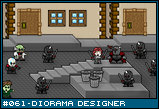| Three Hundred |
| - Index Page |
| - About... |
| - By Year |
| Collections |
| - Comp-Grid |
| - Procedural |
| - Tactics |
| - Tiny Crawl |
| - Misc |
| Previous | Mechanic #061 | Next |
Have you ever been flipping the pages of some magazine and stumbled upon a screenshot of a game you'd never heard of before? Somehow, that screenshot communicated everything that game was. It's like you could gather all the information you needed from it to create this mental placeholder of a game. (Of course, you'd usually buy the game only to discover that the shot was faked and that the game wasn't anything like that, but still...) The human brain is an amazing thing. From a single screenshot, one can invent a complete game at will. Up until now, I've largely been talking about procedural content generation as a design tool, building a complex world based on rules and patterns. But what if procedural content could be used in the same way that seeing a screenshot worked? What if it could fill in the blanks based on the context clues of a single moment in time? What if you gave it the end of the movie and it figured out what the beginning was? The basic concept of [#061 - Diorama Designer] is simple. You build a diorama - a little scene from the level you want to play depicting a moment of interest - and the computer will design the level beginning to end in such a way that a scene like that would be possible. Screenshot to game, not vice versa.
![[diorama1.png]](set04/img/entry061-diorama1.png) This is just something I threw together using some old art, but even this has a lot of information in it that a program can use to interpolate an entire level from. For instance, you've got the location (town), unit types, density of units (about 8 to 1), frequency of unit types (generic minions most common), frequency of trash can containers, the types of weapons they are equipping (or in the case of the hero, Ruby, which weapons she may have found in the area), and even what the big boss is and how he is defeated. Now it would be up to the computer to generate a level from this. It would need to examine the background clues to figure out what the town should be built like and what should be in it. It needs to figure out the different factions of enemies, what their relative power is, what they would be equipping, and so on. Obviously, despite there being enough information there to recreate this scene alone, everything before and after would require more information. Basically, the computer just makes it up. Since there is an evil minion general there and it is set in a town, one can assume it is some sort of town under siege scenario - thus the computer can generate scenes involving townspeople fighting for their lives or put corpses and broken siege equipment in the street and so on. ![[diorama2.png]](set04/img/entry061-diorama2.png) See how just setting it at night, adding a little charring to the walls, and introducing fog can change the whole feeling of the setting? The level would be created the same way, so you can set not just what's in a level but also the mood. Imagine being able to set the colors of each individual enemy in the scene as well (like painting a Warhammer miniature) and having the computer extend that coloring scheme to all related units in the level. I believe this idea would work best with more artistic choices being translated into gameplay rather than trying to figure out how, like, the relationship between each character on the screen represents the relative difficulty and encounter order or some stuff like that.
![[diorama3.png]](set04/img/entry061-diorama3.png) Of course, one quick possibility is that one could make a chain of dioramas - a comic, if you will, of the game experience they'd like. First, I fought some skeletons in the ruins, then met some demons on a bridge, and finally beat down some archers on a fortification. The game would have considerably more clues from which to derive a satisfying gameplay experience, but there would need to be some sort of manner by which players make sure each frame is compatible with the ones that come before it or after... ...Actually, maybe not. Maybe incongruous dioramas could produce rather interesting results. After all, maybe the computer could come up with a really good explanation of why the hero is sipping citrus flavored soda on the Titanic in once scene and is snooping around a graveyard with a flashlight in the next. If not, it'd be a hilarious result none the less.
This is an extremely impractical way of doing things, but it does open itself up to creative on the player's part and presents that creativity in an easily digestible format. For instance, if you wanted to have a contest for level "designer", you would simply have to look at each diorama's screenshot and it could be judged not just on the level it creates, but also the framing and dramatic impact. One should keep in mind that this isn't meant to be primarily a gameplay design tool as much as it is to be a singular artistic expression that the computer draws from to create a companion playable experience.
|
